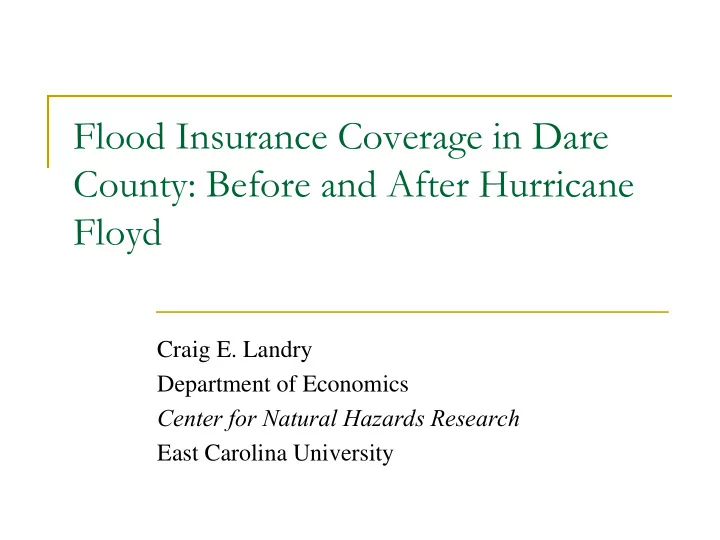

Flood Insurance Coverage in Dare County: Before and After Hurricane Floyd Craig E. Landry Department of Economics Center for Natural Hazards Research East Carolina University
National Flood Insurance Program � Flooding is a ‘catastrophe risk’ � Losses correlated across parcels � Limited data for estimating probabilities & loss � Government provision of disaster relief – ‘charity hazard’ � ‘Adverse selection’ – only risky parcels will insure � Private insurers reluctant to offer flood insurance � National Flood Insurance Program (1968): � Create incentives for sound floodplain management � Make insurance available through partnership with private insurance agencies (sale/service – WYO) Hurricane Floyd Symposium: Sept. 2009 2
National Flood Insurance Program � Initial phases of NFIP– Flood Insurance Rate Maps � Subsidized insurance premium apply to pre-FIRM � Post-FIRM required to meet stricter building standards � Initially, low demand for flood insurance � Subsequent legislation encouraged purchase & mitigation projects � Mandatory coverage for mortgaged properties in SFHA � Incentives for community hazard mitigation – CRS � Erosion losses occurring during flooding covered Hurricane Floyd Symposium: Sept. 2009 3
Objectives � Combine data on flood insurance demand in Dare County for different time periods � How have coverage and deductible changed over time? � Are mandatory provisions being enforced? � How has subsidy status changed over time? � Does demand vary with subsidy status? � Does demand vary by risk classification (flood zone) � How sensitive is demand to price? Income? Demographic factors? Hurricane Floyd Symposium: Sept. 2009 4
Dare County, North Carolina � 386 square miles of land � 30,000 residents; 6 millions tourists/year � 20,400 residential structure – est. replacement value of $2.9 billion (2000 – 2002) � Vulnerable to ocean and sound flooding/storm surge � Source: Dare County Hurricane Mitigation Plan Hurricane Floyd Symposium: Sept. 2009 5
Data � 1998 survey of homeowners in the near coastal zone (included site visits, GIS, and tax assessor data) � Initiated by FEMA to examine influence of erosion on NFIP � N = 1064, but for many variables only about 400 obs. � 2008 survey of homeowners on barrier islands (includes GIS and tax assessor data) � Explore the effect of hazard perceptions on mitigation & behavior (RENCI) � N = 137 Hurricane Floyd Symposium: Sept. 2009 6
Summary Statistics: Dare County Variable 1998 (s.d.) 2008 (s.d.) Test statistic (p) χ 2 = 65.97 (<0.00) Participation 0.533 (0.499) 0.903 (0.296) Flood insurance 121,204 (140,005) 189,859 (85,536) MW = 6.37 (<0.00) (2008$) Building value 114,054 (189,644) 228,296 (166,407) MW = 10.76 (2008$) (<0.00) Insurance/value 0.556 (1.075) 1.147 (0.764) MW = 2.54 (0.0108) Deductible (2008$) 1927 (3623) 3177 (4096) MW = 7.95 (<0.00) χ 2 = 13.26 (<0.00) Mortgaged 0.490 (0.500) 0.760 (0.428) χ 2 = 99.75 (<0.00) Required 0.118 (0.323) 0.615 (0.488) χ 2 = -19.03 (<0.00) Subsidy 0.424 (0.494) 0.232 (0.423) Hurricane Floyd Symposium: Sept. 2009 7
Flood Insurance Coverage (thousands 2008$) � 2008 � Low frequency of non-participants � Many at upper bound � 1998 � High frequency of non-participants � Few at upper bound 8
Methods � Multivariate regression analysis to analyze insurance coverage choice � Tobit model with upper ($0) and lower ($250K) bound – maximum likelihood estimation � Marginal premium � Risk (flood zone) � Assessed building value � Subsidy status, mortgage status � Income, education Hurricane Floyd Symposium: Sept. 2009 9
Results � Price responsiveness: � ε p = -0.645 for average property in 1998 � ε p = -0.018 for average property in 2008 � Coverage in V-zone $29,900 greater � Coverage in A-zone $9800 greater � Very small effect for building value: $1 increase in assessed building value increases coverage by $0.02. Hurricane Floyd Symposium: Sept. 2009 10
Results � Coverage is $14,100 greater for mortgaged properties � $1 increase in household income increases coverage by $0.52 � Coverage lower for those for whom high school is highest level of educational attainment. 11
Discussion: Dare County � Participation in NFIP has increased significantly � This is probably due to better enforcement of federal requirements regarding federally backed mortgages in SFHA (100-year flood zone) � More mortgaged properties � More property owners claim they were required to purchase flood insurance � Coverage amounts have increased (in real dollars) � Deductibles have increased � Number of subsidized properties has decreased Hurricane Floyd Symposium: Sept. 2009 12
Discussion: Dare County � Flood insurance demand is not very responsive to price (likely reflects federal requirements) � Coverage is greater in higher risk zones � Could partly reflect requirements in SFHA � But, V-zone is much greater than A-zone � Coverage greater for higher valued buildings � Coverage increasing in income and education
Conclusions � Flood insurance coverage along the coast of NC appears to have increased since Hurricane Floyd � There are still parcels that qualify for subsidized flood insurance, but the proportion has decreased � Coverage demand is not price sensitive � Coverage greater in higher risk zones and for more valuable structures � Coverage higher for wealthy and more educated Hurricane Floyd Symposium: Sept. 2009 14
Center for Natural Hazards Research Hurricane Floyd Symposium: Sept. 2009
Hurricanes in Dare County � 1999 � Dennis : Aug. 28 to Sept 4 � Stalled along the Outer Banks, pounded barrier island for 3 days, then looped back to make landfall on Cedar Island. � Thousands of people who did not evacuate were stranded and lashed with 70 mph winds. Beach erosion was massive. � Flooding stats 16
Hurricanes in Dare County � 1999 � Floyd : Sept. 15-16 � Weakened from a cat 5 to a cat 2, brushed the NC coast. � Left behind record rainfall in an already saturated area. � Flooding stats � Largest natural disaster in state history � SOURCE: http://www.enctoday.com/articles/storm- 4330-hurricane-north.html 17
Recommend
More recommend